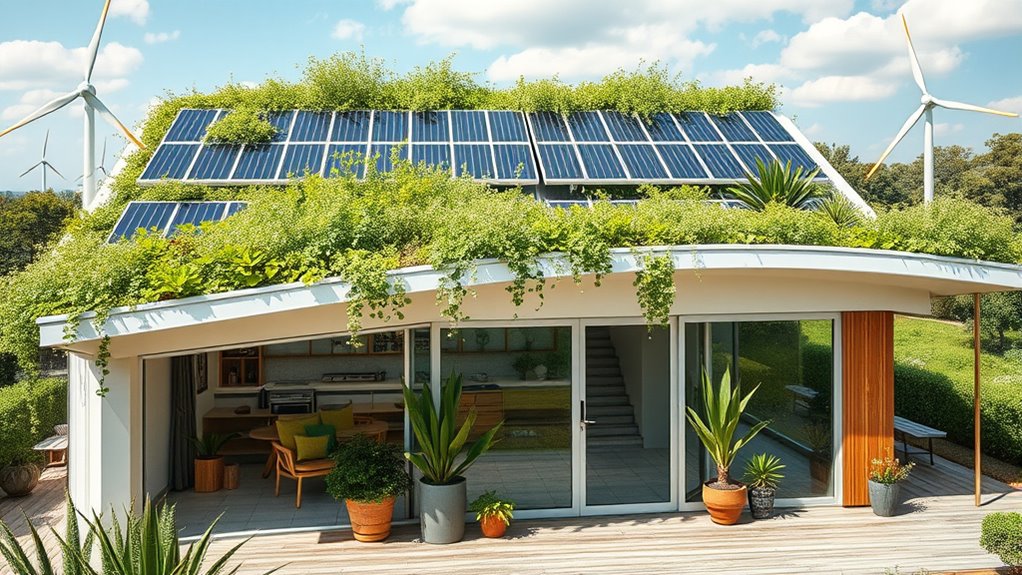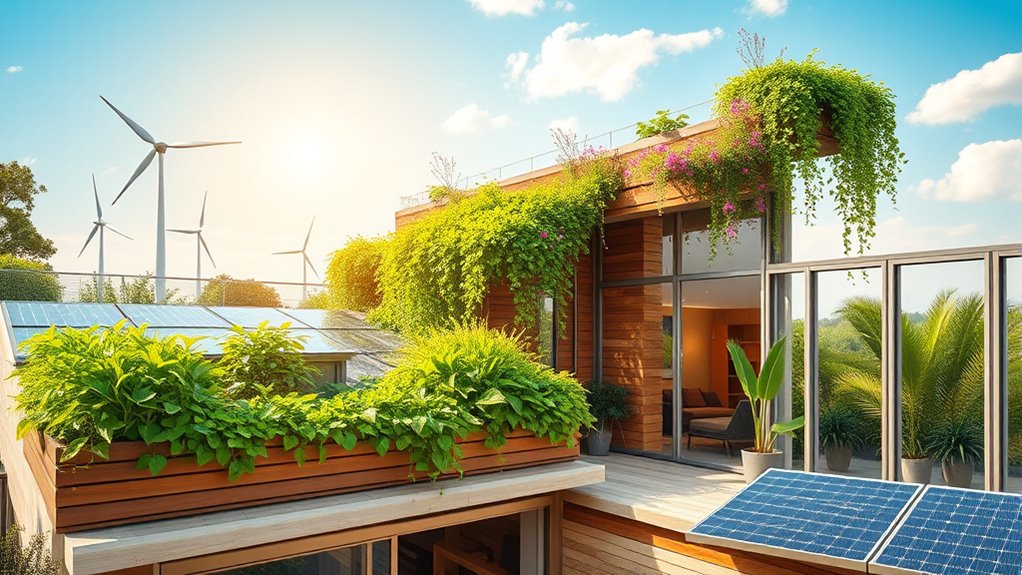In 2025, eco-friendly living means embracing solar energy, water-saving fixtures, and sustainable design practices that boost efficiency and cut costs. You can install solar panels easily and benefit from incentives, while low-flow fixtures and rainwater harvesting help conserve resources. These upgrades enhance your home’s resilience and value without sacrificing style. To discover more ways you can make your home greener and smarter, keep exploring the latest sustainable trends.
Key Takeaways
- Solar panel integration remains a top trend, boosting energy independence and reducing utility costs in homes.
- Water conservation through smart fixtures, rainwater harvesting, and greywater systems continues to grow in popularity.
- Sustainable home upgrades blend eco-friendly solutions with modern design for aesthetic appeal and efficiency.
- Incentives and rebates encourage wider adoption of renewable energy and water-saving technologies.
- Eco-conscious living practices contribute to climate change mitigation and enhance overall home resilience and value.

As more people prioritize environmental responsibility, sustainable home trends are gaining momentum. You’re likely noticing how innovative solutions are making eco-friendly living more accessible and practical. One of the most prominent trends is the integration of solar technology into residential spaces. Installing solar panels allows you to harness the sun’s energy, reducing reliance on fossil fuels and lowering your utility bills. Modern solar systems are more efficient and affordable than ever, making it easier for you to adopt renewable energy sources. Plus, many communities now offer incentives or rebates that can offset installation costs, encouraging more homeowners to go solar. By investing in solar technology, you’re not only cutting your carbon footprint but also increasing your home’s value and resilience against energy price fluctuations.
Alongside solar tech, water conservation has become a key focus in sustainable living. You can make a significant difference by installing low-flow fixtures, such as showerheads and faucets, which reduce water use without sacrificing performance. Additionally, capturing rainwater for landscaping or using greywater systems helps you conserve this precious resource. Smart irrigation controllers that adjust watering schedules based on weather forecasts also prevent overwatering, saving water and money. These practices are especially important as climate change causes more frequent droughts and water shortages. By adopting water conservation measures, you’re actively contributing to environmental protection and reducing your water bills. It’s a straightforward way to make your home more eco-friendly without major renovations. Moreover, understanding how contrast ratio influences image quality can help you select the right projector for your home cinema setup, ensuring vibrant visuals that enhance your viewing experience.
Incorporating these trends into your home doesn’t mean sacrificing comfort or convenience. Solar technology can be seamlessly integrated into your existing roof or as part of a new build, offering clean energy without disrupting your daily routine. Water-saving appliances and fixtures are designed for ease of use and can be incorporated into your kitchen and bathroom upgrades. These upgrades often come with modern designs that complement your home’s aesthetic while boosting efficiency. As you embrace these sustainable practices, you’ll find that they often lead to long-term savings and a greater sense of environmental stewardship.
Frequently Asked Questions
How Will Smart Technology Enhance Eco-Friendly Homes in 2025?
Smart technology will considerably enhance eco-friendly homes in 2025 by enabling smart automation and energy monitoring. You’ll find that intelligent systems automatically adjust lighting, heating, and cooling to save energy without sacrificing comfort. With real-time energy monitoring, you can track your consumption and make smarter choices, reducing your carbon footprint. These innovations make your home more sustainable, cost-effective, and aligned with eco-friendly living principles.
What Are the Costs Associated With Sustainable Home Upgrades?
When considering sustainable home upgrades, you should do a thorough cost analysis to understand expenses. Budgeting strategies help you plan effectively, ensuring you allocate funds wisely for solar panels, energy-efficient appliances, or insulation. While some upgrades require significant investment upfront, they often lead to long-term savings on energy bills. By comparing costs and benefits, you can make informed decisions that balance eco-friendliness with your financial goals.
How Do Government Incentives Support Eco-Friendly Home Improvements?
You’re on the right track to making eco-friendly upgrades happen. Government incentives like grants and tax credits can be a game-changer, easing the financial burden of sustainable home improvements. These programs provide funds upfront or reduce your tax bill, making green upgrades more accessible. By taking advantage of government support, you turn a mountain into a molehill, helping you create an eco-friendly home without breaking the bank.
What Challenges Exist in Implementing Sustainable Materials?
When implementing sustainable materials, you face challenges like ensuring responsible material sourcing and minimizing manufacturing impacts. Sourcing eco-friendly materials can be difficult due to limited availability or higher costs. Additionally, manufacturing impacts, such as energy use and waste, can hinder sustainability goals. You need to carefully evaluate supply chains and production methods to select truly eco-conscious options, balancing environmental benefits with practicality and budget constraints.
How Can Homeowners Ensure Long-Term Eco-Friendly Maintenance?
Imagine installing solar panels and water-efficient fixtures in your home. To guarantee long-term eco-friendly maintenance, you should regularly monitor your renewable energy system’s performance and perform routine water conservation checks. Staying updated on new eco-friendly technologies and adopting a proactive approach helps you maintain sustainability effortlessly. Additionally, creating a maintenance schedule ensures your home remains energy-efficient and water-conscious, supporting your commitment to eco-friendly living for years to come.
Conclusion
Imagine your home as a tiny forest, where every eco-friendly choice is a leaf that helps the whole tree thrive. By embracing sustainable trends in 2025, you’re not just living better—you’re nurturing a vibrant, resilient ecosystem that sustains future generations. Your efforts become the roots that anchor a greener world, and each mindful decision is a branch reaching toward a brighter, healthier planet. Together, you and your home can grow into a beautiful, sustainable sanctuary.









